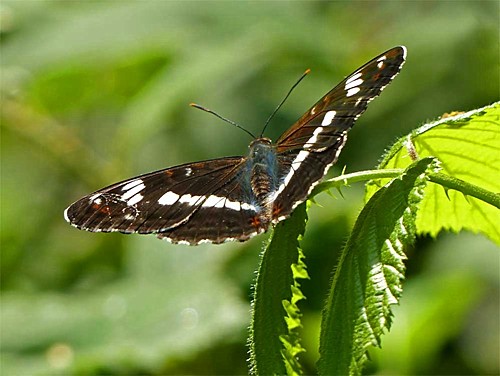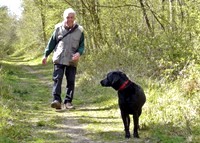The white admiral
ONE OF OUR
THREATENED SPECIES
PHOTOGRAPHED
BY GEOFF BELL

The white admiral
ONE OF OUR
THREATENED SPECIES
PHOTOGRAPHED
BY GEOFF BELL

|
Although they spread rapidly after the 1920s, population monitoring has since shown a dramatic decline in their numbers during the last twenty years for reasons that are as yet unclear. They can be found in mixed deciduous and conifer woodland but prefer fine weather and as all but a few survive prolonged periods without sunshine, sightings are rare. The white admiral has a 2¼ in. wing span and is a powerful flyer with a distinctive pattern of short periods of wing beats followed by long glides and can sometimes be seen skimming along the woodland rides. It has bold markings, the upper parts of the wings being black with a white band and the undersides ornamented in brown and white. They seek open woods with plenty of bramble whose flowers provide a nectar which is their favourite food and it is probably injuries from the bramble thorns that give this butterfly a tattered appearance. Nevertheless, these insects are beautiful to behold and the name white admiral is actually a corruption of the description “white admirable” which is indeed a tribute to its beauty. They also have a preference for honeysuckle growing in shady places for the successful development of their larvae and our woods have these trees in abundance. The females fly in dappled sunlight to lay their eggs, a single one on each leaf, and it is these leaves which are the food plant of the resulting caterpillars that are coloured green with reddish-brown hairs. They hibernate from autumn through to the following summer, when they pupate and after approximately two weeks the butterfly emerges to be seen mainly in July and August. Bourne Wood therefore produces the most favourable conditions for them at this time of the year but the few that inhabit this place are still difficult to spot by all except the most vigilant and photographing them is even harder.
Our guest photographer, Geoff Bell, who regularly walks
the woods with his labrador, Guy, has been trying to photograph the white
admiral for the past twenty years without success but earlier this month his
patience was rewarded when he spotted one flitting among the brambles alongside
a little used downward path from the west side of the wood that emerges opposite
the visitor notice board a short distance from the main car park.
|
 |
THE PHOTOGRAPHER |
![]()
Go to: Main Index Villages Index